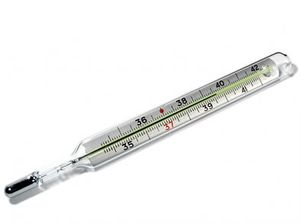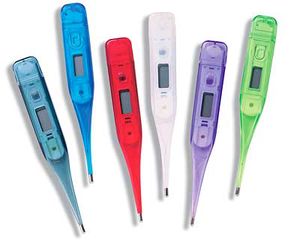Thermometers
Thermometer is a device that measures temperature or temperature gradient using a variety of different principles.A thermometer has two important elements: the temperature sensor in which some physical change occurs with temperature, plus some means of converting this physical change into a numerical value .
Temperature
While an individual thermometer is able to measure degrees of hotness, the readings on two thermometers cannot be compared unless they conform to an agreed scale. There is today an absolute thermodynamic temperature scale. Internationally agreed temperature scales are designed to approximate this closely, based on fixed points and interpolating thermometers. The most recent official temperature scale is the International Temperature Scale of 1990. It extends from 0.65 K (−272.5 °C; −458.5 °F) to approximately 1,358 K (1,085 °C; 1,985 °F).
Primary and secondary thermometers
Thermometers can be divided into two separate groups according to the level of knowledge about the physical basis of the underlying thermodynamic laws and quantities. For primary thermometers the measured property of matter is known so well that temperature can be calculated without any unknown quantities. Examples of these are thermometers based on the equation of state of a gas, on the velocity of sound in a gas, on the thermal noise, voltage or current of an electrical resistor, on blackbody radiation, and on the angular anisotropy of gamma ray emission of certain radioactive nuclei in amagnetic field. Primary thermometers are relatively complex.Secondary thermometers are most widely used because of their convenience. Also, they are often much more sensitive than primary ones. For secondary thermometers knowledge of the measured property is not sufficient to allow direct calculation of temperature. They have to be calibrated against a primary thermometer at least at one temperature or at a number of fixed temperatures. Such fixed points, for example, triple points and superconducting transitions, occur reproducibly at the same temperature.
Uses
Thermometers have been built which utilize a range of physical effects to measure temperature. Temperature sensors are used in a wide variety of scientific and engineering applications, especially measurement systems. Temperature systems are primarily either electrical or mechanical, occasionally inseparable from the system which they control . Thermometers are used within roadways in cold weather climates to help determine if icing conditions exist. Indoors, thermistors are used in climate control systems such as air conditioners, freezers, heaters, refrigerators, and water heaters.Galileo thermometers are used to measure indoor air temperature, due to their limited measurement range.
Alcohol thermometers, infrared thermometers, mercury-in-glass thermometers, recording thermometers, thermistors, and six's thermometers are used outside in areas which are well-exposed to the elements at various levels of the Earth's atmosphere and within the Earth's oceans is necessary within the fields of meteorology and climatology. Aircraft use thermometers and hygrometers to determine if atmospheric icing conditions exist along their flight path, and these measurements are used to initialize weather forecast models. Thermometers are used within roadways in cold weather climates to help determine if icing conditions exist and indoors within climate control systems.
Bi-metallic stemmed thermometers, thermocouples, infrared thermometers, and thermistors are handy during cooking in order to know if meat has been properly cooked. Temperature of food is important because if it sits within environments with a temperature between 5 and 57 °C (41 and 135 °F) for four hours or more, bacteria can multiply leading to foodborne illnesses.Thermometers are used in the production of candy.Medical thermometers such as mercury-in-glass thermometers,infrared thermometers,pill thermometers, and liquid crystal thermometers are used within health care to determine if individuals have a fever or are hypothermic.
Thermochromic liquid crystals are also used in mood rings and in thermometers used to measure the temperature of water in fish tanks.Fiber Bragg grating temperature sensors are used within nuclear power facilities to monitor reactor core temperatures and avoid the possibility of nuclear meltdowns.A thermometer constructed for probing stored food is also sometimes called a temperature wand.
Various types of thermometer
- Alcohol thermometer
- Beckmann differential thermometer
- Bi-metal mechanical thermometer
- Coulomb blockade thermometer
- Heat meter
- Liquid crystal thermometer
- Phosphor thermometry
- Pyrometer
- Quartz thermometer
- Rectal thermometry
- Resistance thermometer
- Reversing thermometer
- Silicon bandgap temperature sensor
- Temperature strip
- Wearable thermometer

